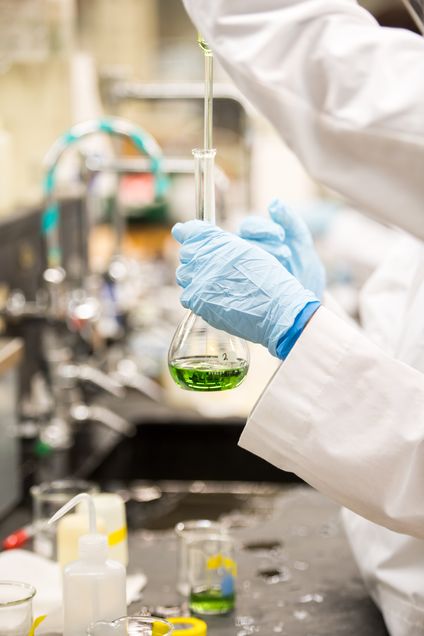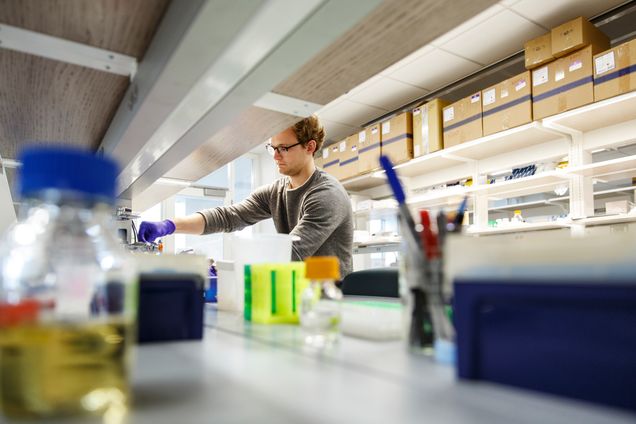Faculty Labs
The Center for Multiscale and Translational Mechanobiology (CMTM) includes many outstanding faculty who are housed in a wide range of locations on both the Charles River and Medical Campuses. Find out more about their laboratory space and research below.

The Bionic Pancreas Team is a collaborative group from Boston University and Massachusetts General Hospital working together to make automated blood glucose control a reality.
The Cell & Tissue Mechanics Lab’s technical expertise lies at the intersection of biology, mechanics, and physics. Our experimental projects span a wide range of size scales including nanoparticle design for targeted drug delivery, tensile testing of extracellular matrix fibers, quantifying biological response to stretch in cells and tissue strips, and measuring total pulmonary mechanical function in ventilated patients.
The Chen Lab seeks to understand how cells interact with their environment, and to use this knowledge to control cell function. In particular, we are studying the cooperation between adhesive, mechanical and biochemical signaling in the regulation of angiogenesis and stem cell biology.
The Connizzo Lab takes a novel approach to understanding soft tissue aging by identifying age-related changes in: Cells, the surrounding extracellular matrix (ECM), and tissue mechanical function; the ability of cells to sense mechanical and biochemical cues through the ECM; and the homeostatic regulation of ECM structure through remodeling.
The Cui Group is a research group in the Department of Chemistry at Boston University. We develop and apply a multitude of theoretical and computational methods to tackle some of the most challenging and exciting problems in molecular biophysics.

The Divieti Pajevic Lab is interested in investigating the effects of hormones (parathyroid hormone; PTH), intracellular signaling (Gsa subunit) and mechanical forces (gravity) on osteocytes both “in vivo”, using genetically modified animal models, and “in vitro” using novel osteocytic cell line.
The Eyckmans Lab is interested in how cells repair and rebuild tissues and organs after injury. Informed by in vivo animal studies, they develop biomimetic tissue culture models that emulate tissue repair and morphogenesis of soft (such as skin, tendon, muscle) and mineralized (bone, tooth) tissues. Using these model systems, they investigate the molecular and mechanical signaling mechanisms that control tissue repair and regeneration.
The Grinstaff Group pursues highly interdisciplinary research in the areas of biological and macromolecular chemistry. The major goal in these research projects is to elucidate the underlying fundamental chemistry and engineering principles and to use that insight to direct our creative and scientific efforts.
The Growth Factor Mechanobiology Lab investigates an exciting, growing area of mechanobiology: the role of mechanical and extracellular interactions on the activity of growth factors in musculoskeletal tissues.

The Human Adaption Laboratory is dedicated to furthering the understanding of motor adaptation and developing interventions to reduce hip pain.
The interest of the Kamenetska Research Group is in untangling structure-property relationships on the nanoscale using single molecule spectroscopies.
Throughout evolutionary history, life has explored the laws of physics, creating remarkable new strategies to perpetuate itself. The Larkin Lab is a research group that seeks to understand how these strategies arise using microbial populations as a model. We are interested in how the physical and chemical environment influences microbes, and how these microbes in turn engineer that very environment.
The primary goal of the Matthew D. Layne Lab is to identify novel pathways that control extracellular matrix (ECM) synthesis and assembly as they relate to fibroproliferative and connective tissue diseases.

The goal of the Lejeune Lab is to leverage the state of the art in computational mechanics to investigate multiscale emergent behavior in biological systems, make patient-specific medicine a reality through simulation, and inform medical protocol through mechanical analysis.
The Matrix Mechanotransduction Laboratory studies the interface of cell mechanics and extracellular matrix mechanobiology with the use of novel tools for wet lab experimentation and computational modeling.
The main focus of the Morgan Lab is the differentiated smooth muscle cell, which forms the walls of most of the hollow organs in the body. Inappropriate contraction or relaxation of smooth muscle is responsible for a number of diseases including stroke, hypertension, heart failure, asthma and premature labor.

The Movement & Applied Imaging Lab is a trans-disciplinary collaboration with the objective of preventing and managing musculoskeletal disorders, primarily osteoarthritis.
The Multi-Scale Tissue Biomechanics Lab investigates the mechanics and mechanobiology of the extracellular matrix (ECM) at multi-scale using both experimental and advanced computational modeling techniques.
The Ngo Lab studies how molecules are organized within and between cells, with the goal of understanding how changes in organization give rise to dynamic biological processes.

The Nia Laboratory conducts research on tumor microenvironment (TME) with a focus on physical hallmarks of cancer.
The Orthopedic Research Laboratory at Boston University is dedicated to exploring the scientific basis of musculoskeletal diseases and injuries and to developing new technologies for the improvement of musculoskeletal function.

The Respiratory and Physiological Systems Identification Laboratory is currently involved in the development of novel linear and nonlinear systems identification approaches for probing mechanisms associated with healthy and diseased physiological systems and with principal applications in respiratory physiology.
The research of the Ravid Lab is focused on two interrelated projects that bear on mechanisms associated with the development of blood and vascular pathologies: (1) molecular mechanisms involved in bone marrow megakaryocyte/platelet development; (2) the role of vascular and bone marrow cell (mesenchymal stem cells) adenosine receptors in tissue regeneration.
The Seta Lab studies the basic mechanisms of vascular diseases, with an emphasis on the biology of the vascular smooth muscle.
The Skeletal Mechanobiology and Biomechanics Laboratory are a team of researchers and bone geeks, working on advancing current understanding of the role of the mechanical function of tissues and organs in skeletal health, repair, and development. For our fellow bone geeks, we are providing rigorous education and training in multidisciplinary engineering research.

The Skeletal Muscle Physiology Laboratory is at the forefront of investigations focused on developing preclinical animal models of frailty and teasing out the underlying etiology of frailty and sarcopenia.
The Varelas Laboratory uses molecular and genetic approaches to understand how cell polarity and mechanical cues direct the activity of the transcriptional effectors YAP and TAZ to control mammalian organ development, homeostasis and disease processes.
The Joyce Y. Wong Laboratory develops biomaterials to detect and treat disease. Current projects include tissue engineering for pediatric cardiovascular disease, theranostics for post-surgical adhesions, and biomaterials for women’s health.
The vision of the Yang Research Laboratory is developing new nanomaterials with functionality gained from low dimensionality, structural and compositional complexity, and novel optical and electrical properties and for great societal impact.

Research in the Zaman Laboratory the incorporates tools from cell biology, mechanics, systems biology, medicine, and phamacology and is organized around two key areas: understanding and decoupling the integrated chemical, biological and mechanical basis of tumor invasion that precedes metastasis; and developing robust technologies and innovative solutions to improve the quality and practice of medicine in the developing world.
